Nike's Marketing Mix and Response to Environmental Challenges
VerifiedAdded on 2022/08/15
|12
|3885
|13
Essay
AI Summary
This essay provides a comprehensive analysis of Nike's marketing mix, encompassing its product offerings, pricing strategies, distribution channels (place), and promotional activities. It delves into how Nike has established its brand presence and market leadership through effective use of the marketing mix. The essay further examines Nike's response to marketing environmental challenges, particularly concerning sustainability and waste reduction. It highlights Nike's initiatives to minimize environmental impacts throughout the product life cycle, from design and manufacturing to disposal. The analysis includes specific examples of Nike's efforts to reduce waste, such as the use of regrind technology and a focus on designing waste out of products. The essay also references the PESTLE analysis, economic factors, and the Materials Sustainability Index (MSI) to provide a broader context of the environmental issues Nike faces and its strategic responses.

Marketing and services management
Paraphrase This Document
Need a fresh take? Get an instant paraphrase of this document with our AI Paraphraser

Marketing and services management 1
Contents
Nike’s marketing mix approach.............................................................................................................2
Responding to marketing environmental challenges..............................................................................5
References.............................................................................................................................................9
Contents
Nike’s marketing mix approach.............................................................................................................2
Responding to marketing environmental challenges..............................................................................5
References.............................................................................................................................................9
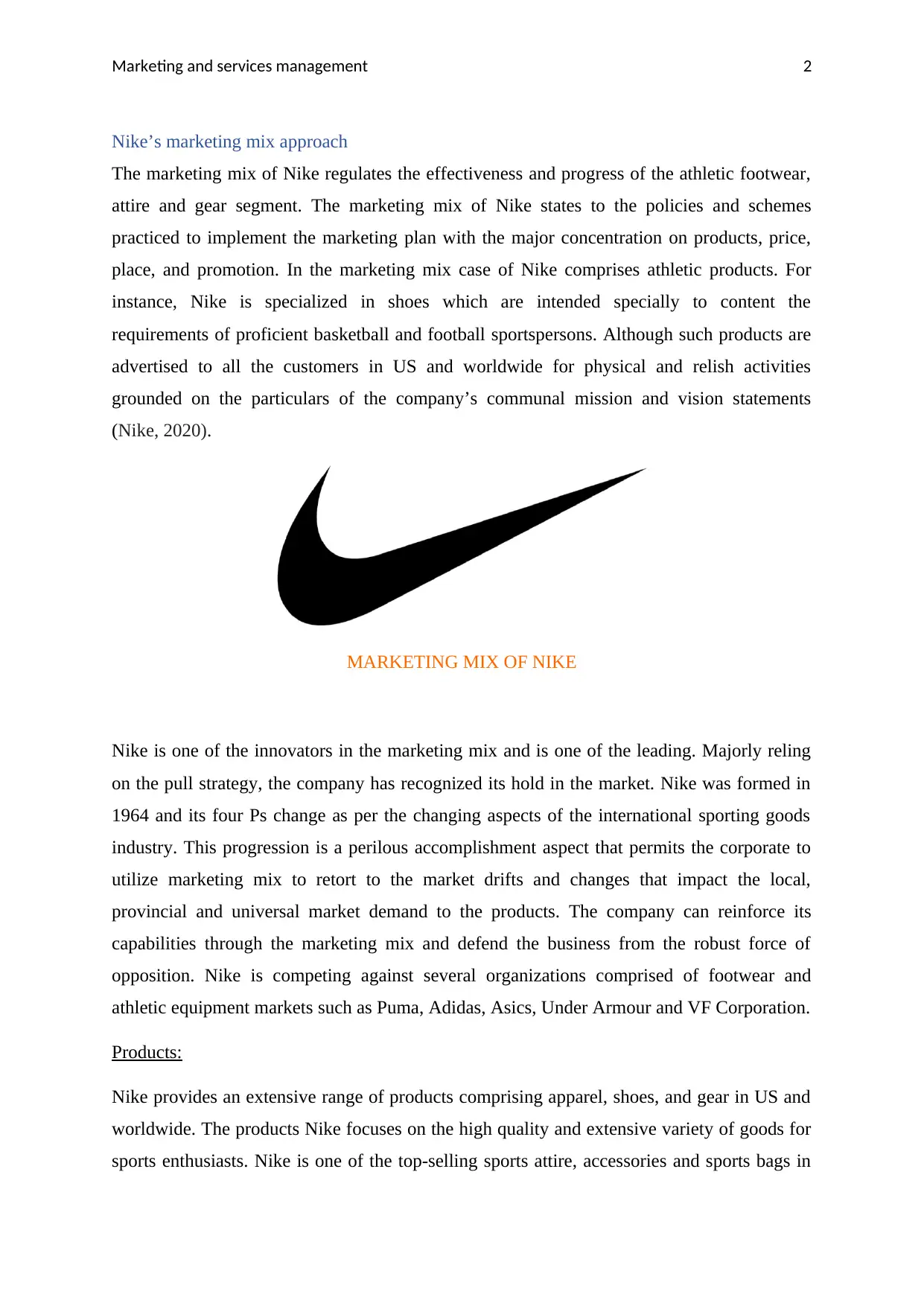
Marketing and services management 2
Nike’s marketing mix approach
The marketing mix of Nike regulates the effectiveness and progress of the athletic footwear,
attire and gear segment. The marketing mix of Nike states to the policies and schemes
practiced to implement the marketing plan with the major concentration on products, price,
place, and promotion. In the marketing mix case of Nike comprises athletic products. For
instance, Nike is specialized in shoes which are intended specially to content the
requirements of proficient basketball and football sportspersons. Although such products are
advertised to all the customers in US and worldwide for physical and relish activities
grounded on the particulars of the company’s communal mission and vision statements
(Nike, 2020).
MARKETING MIX OF NIKE
Nike is one of the innovators in the marketing mix and is one of the leading. Majorly reling
on the pull strategy, the company has recognized its hold in the market. Nike was formed in
1964 and its four Ps change as per the changing aspects of the international sporting goods
industry. This progression is a perilous accomplishment aspect that permits the corporate to
utilize marketing mix to retort to the market drifts and changes that impact the local,
provincial and universal market demand to the products. The company can reinforce its
capabilities through the marketing mix and defend the business from the robust force of
opposition. Nike is competing against several organizations comprised of footwear and
athletic equipment markets such as Puma, Adidas, Asics, Under Armour and VF Corporation.
Products:
Nike provides an extensive range of products comprising apparel, shoes, and gear in US and
worldwide. The products Nike focuses on the high quality and extensive variety of goods for
sports enthusiasts. Nike is one of the top-selling sports attire, accessories and sports bags in
Nike’s marketing mix approach
The marketing mix of Nike regulates the effectiveness and progress of the athletic footwear,
attire and gear segment. The marketing mix of Nike states to the policies and schemes
practiced to implement the marketing plan with the major concentration on products, price,
place, and promotion. In the marketing mix case of Nike comprises athletic products. For
instance, Nike is specialized in shoes which are intended specially to content the
requirements of proficient basketball and football sportspersons. Although such products are
advertised to all the customers in US and worldwide for physical and relish activities
grounded on the particulars of the company’s communal mission and vision statements
(Nike, 2020).
MARKETING MIX OF NIKE
Nike is one of the innovators in the marketing mix and is one of the leading. Majorly reling
on the pull strategy, the company has recognized its hold in the market. Nike was formed in
1964 and its four Ps change as per the changing aspects of the international sporting goods
industry. This progression is a perilous accomplishment aspect that permits the corporate to
utilize marketing mix to retort to the market drifts and changes that impact the local,
provincial and universal market demand to the products. The company can reinforce its
capabilities through the marketing mix and defend the business from the robust force of
opposition. Nike is competing against several organizations comprised of footwear and
athletic equipment markets such as Puma, Adidas, Asics, Under Armour and VF Corporation.
Products:
Nike provides an extensive range of products comprising apparel, shoes, and gear in US and
worldwide. The products Nike focuses on the high quality and extensive variety of goods for
sports enthusiasts. Nike is one of the top-selling sports attire, accessories and sports bags in
⊘ This is a preview!⊘
Do you want full access?
Subscribe today to unlock all pages.

Trusted by 1+ million students worldwide
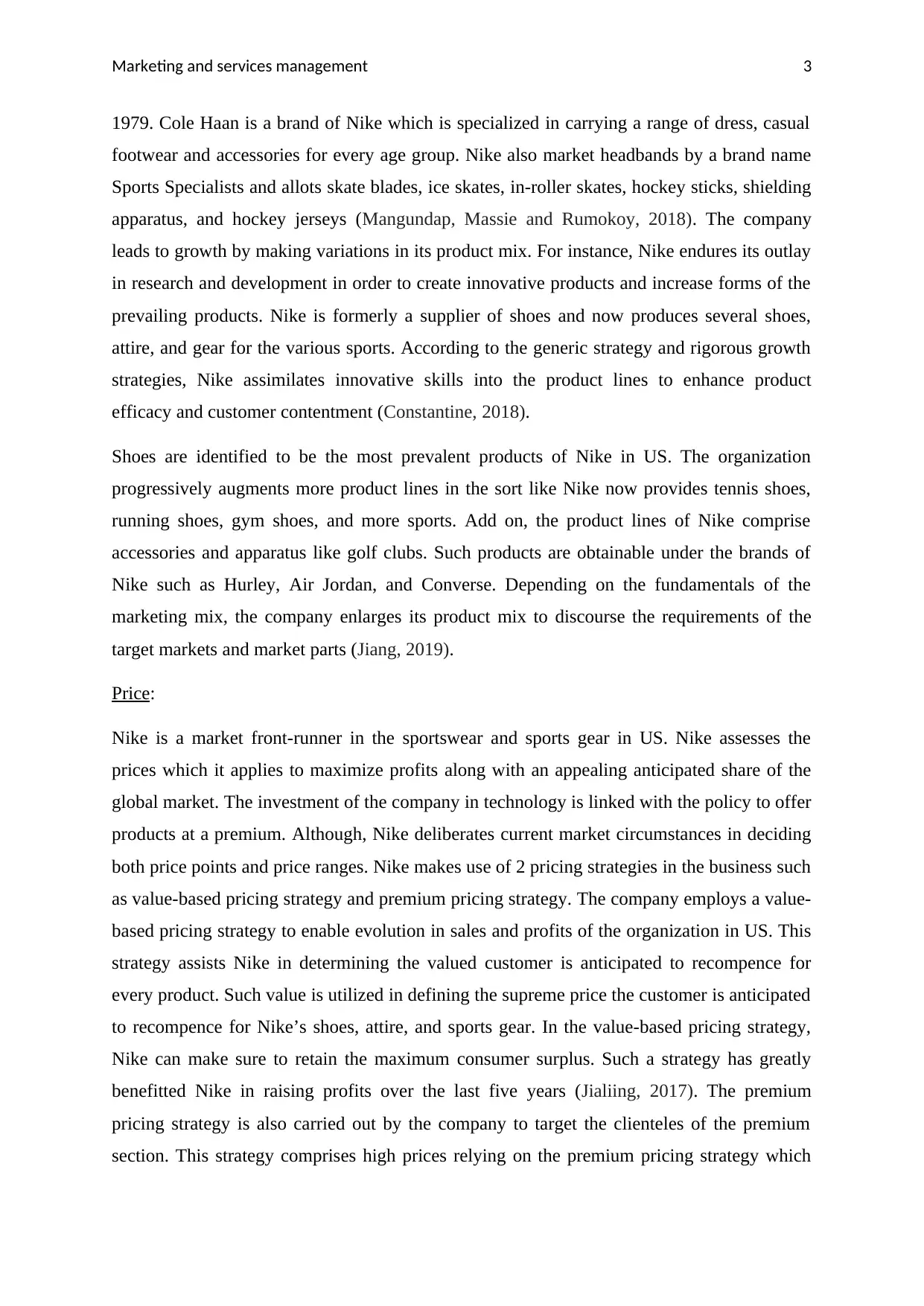
Marketing and services management 3
1979. Cole Haan is a brand of Nike which is specialized in carrying a range of dress, casual
footwear and accessories for every age group. Nike also market headbands by a brand name
Sports Specialists and allots skate blades, ice skates, in-roller skates, hockey sticks, shielding
apparatus, and hockey jerseys (Mangundap, Massie and Rumokoy, 2018). The company
leads to growth by making variations in its product mix. For instance, Nike endures its outlay
in research and development in order to create innovative products and increase forms of the
prevailing products. Nike is formerly a supplier of shoes and now produces several shoes,
attire, and gear for the various sports. According to the generic strategy and rigorous growth
strategies, Nike assimilates innovative skills into the product lines to enhance product
efficacy and customer contentment (Constantine, 2018).
Shoes are identified to be the most prevalent products of Nike in US. The organization
progressively augments more product lines in the sort like Nike now provides tennis shoes,
running shoes, gym shoes, and more sports. Add on, the product lines of Nike comprise
accessories and apparatus like golf clubs. Such products are obtainable under the brands of
Nike such as Hurley, Air Jordan, and Converse. Depending on the fundamentals of the
marketing mix, the company enlarges its product mix to discourse the requirements of the
target markets and market parts (Jiang, 2019).
Price:
Nike is a market front-runner in the sportswear and sports gear in US. Nike assesses the
prices which it applies to maximize profits along with an appealing anticipated share of the
global market. The investment of the company in technology is linked with the policy to offer
products at a premium. Although, Nike deliberates current market circumstances in deciding
both price points and price ranges. Nike makes use of 2 pricing strategies in the business such
as value-based pricing strategy and premium pricing strategy. The company employs a value-
based pricing strategy to enable evolution in sales and profits of the organization in US. This
strategy assists Nike in determining the valued customer is anticipated to recompence for
every product. Such value is utilized in defining the supreme price the customer is anticipated
to recompence for Nike’s shoes, attire, and sports gear. In the value-based pricing strategy,
Nike can make sure to retain the maximum consumer surplus. Such a strategy has greatly
benefitted Nike in raising profits over the last five years (Jialiing, 2017). The premium
pricing strategy is also carried out by the company to target the clienteles of the premium
section. This strategy comprises high prices relying on the premium pricing strategy which
1979. Cole Haan is a brand of Nike which is specialized in carrying a range of dress, casual
footwear and accessories for every age group. Nike also market headbands by a brand name
Sports Specialists and allots skate blades, ice skates, in-roller skates, hockey sticks, shielding
apparatus, and hockey jerseys (Mangundap, Massie and Rumokoy, 2018). The company
leads to growth by making variations in its product mix. For instance, Nike endures its outlay
in research and development in order to create innovative products and increase forms of the
prevailing products. Nike is formerly a supplier of shoes and now produces several shoes,
attire, and gear for the various sports. According to the generic strategy and rigorous growth
strategies, Nike assimilates innovative skills into the product lines to enhance product
efficacy and customer contentment (Constantine, 2018).
Shoes are identified to be the most prevalent products of Nike in US. The organization
progressively augments more product lines in the sort like Nike now provides tennis shoes,
running shoes, gym shoes, and more sports. Add on, the product lines of Nike comprise
accessories and apparatus like golf clubs. Such products are obtainable under the brands of
Nike such as Hurley, Air Jordan, and Converse. Depending on the fundamentals of the
marketing mix, the company enlarges its product mix to discourse the requirements of the
target markets and market parts (Jiang, 2019).
Price:
Nike is a market front-runner in the sportswear and sports gear in US. Nike assesses the
prices which it applies to maximize profits along with an appealing anticipated share of the
global market. The investment of the company in technology is linked with the policy to offer
products at a premium. Although, Nike deliberates current market circumstances in deciding
both price points and price ranges. Nike makes use of 2 pricing strategies in the business such
as value-based pricing strategy and premium pricing strategy. The company employs a value-
based pricing strategy to enable evolution in sales and profits of the organization in US. This
strategy assists Nike in determining the valued customer is anticipated to recompence for
every product. Such value is utilized in defining the supreme price the customer is anticipated
to recompence for Nike’s shoes, attire, and sports gear. In the value-based pricing strategy,
Nike can make sure to retain the maximum consumer surplus. Such a strategy has greatly
benefitted Nike in raising profits over the last five years (Jialiing, 2017). The premium
pricing strategy is also carried out by the company to target the clienteles of the premium
section. This strategy comprises high prices relying on the premium pricing strategy which
Paraphrase This Document
Need a fresh take? Get an instant paraphrase of this document with our AI Paraphraser
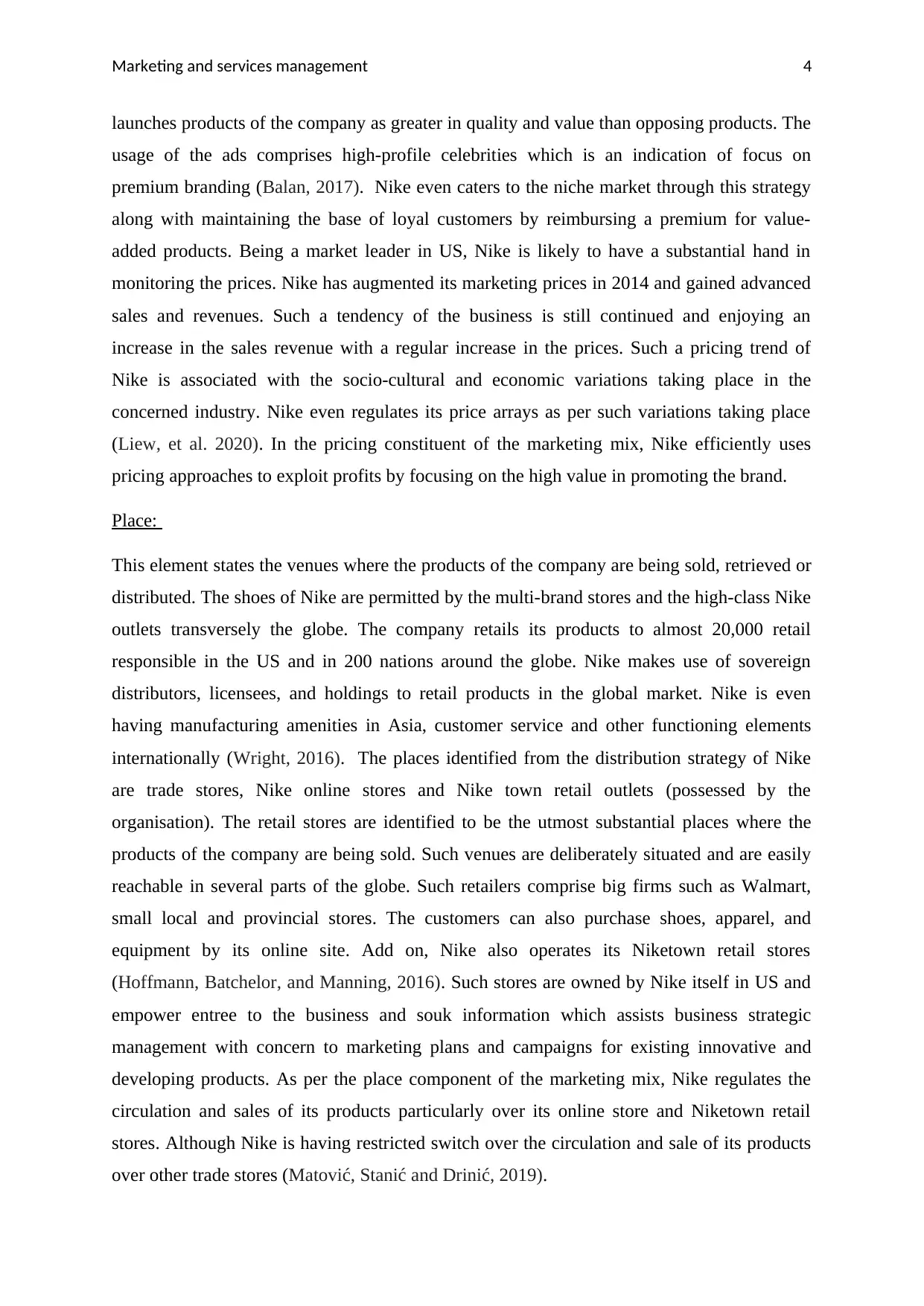
Marketing and services management 4
launches products of the company as greater in quality and value than opposing products. The
usage of the ads comprises high-profile celebrities which is an indication of focus on
premium branding (Balan, 2017). Nike even caters to the niche market through this strategy
along with maintaining the base of loyal customers by reimbursing a premium for value-
added products. Being a market leader in US, Nike is likely to have a substantial hand in
monitoring the prices. Nike has augmented its marketing prices in 2014 and gained advanced
sales and revenues. Such a tendency of the business is still continued and enjoying an
increase in the sales revenue with a regular increase in the prices. Such a pricing trend of
Nike is associated with the socio-cultural and economic variations taking place in the
concerned industry. Nike even regulates its price arrays as per such variations taking place
(Liew, et al. 2020). In the pricing constituent of the marketing mix, Nike efficiently uses
pricing approaches to exploit profits by focusing on the high value in promoting the brand.
Place:
This element states the venues where the products of the company are being sold, retrieved or
distributed. The shoes of Nike are permitted by the multi-brand stores and the high-class Nike
outlets transversely the globe. The company retails its products to almost 20,000 retail
responsible in the US and in 200 nations around the globe. Nike makes use of sovereign
distributors, licensees, and holdings to retail products in the global market. Nike is even
having manufacturing amenities in Asia, customer service and other functioning elements
internationally (Wright, 2016). The places identified from the distribution strategy of Nike
are trade stores, Nike online stores and Nike town retail outlets (possessed by the
organisation). The retail stores are identified to be the utmost substantial places where the
products of the company are being sold. Such venues are deliberately situated and are easily
reachable in several parts of the globe. Such retailers comprise big firms such as Walmart,
small local and provincial stores. The customers can also purchase shoes, apparel, and
equipment by its online site. Add on, Nike also operates its Niketown retail stores
(Hoffmann, Batchelor, and Manning, 2016). Such stores are owned by Nike itself in US and
empower entree to the business and souk information which assists business strategic
management with concern to marketing plans and campaigns for existing innovative and
developing products. As per the place component of the marketing mix, Nike regulates the
circulation and sales of its products particularly over its online store and Niketown retail
stores. Although Nike is having restricted switch over the circulation and sale of its products
over other trade stores (Matović, Stanić and Drinić, 2019).
launches products of the company as greater in quality and value than opposing products. The
usage of the ads comprises high-profile celebrities which is an indication of focus on
premium branding (Balan, 2017). Nike even caters to the niche market through this strategy
along with maintaining the base of loyal customers by reimbursing a premium for value-
added products. Being a market leader in US, Nike is likely to have a substantial hand in
monitoring the prices. Nike has augmented its marketing prices in 2014 and gained advanced
sales and revenues. Such a tendency of the business is still continued and enjoying an
increase in the sales revenue with a regular increase in the prices. Such a pricing trend of
Nike is associated with the socio-cultural and economic variations taking place in the
concerned industry. Nike even regulates its price arrays as per such variations taking place
(Liew, et al. 2020). In the pricing constituent of the marketing mix, Nike efficiently uses
pricing approaches to exploit profits by focusing on the high value in promoting the brand.
Place:
This element states the venues where the products of the company are being sold, retrieved or
distributed. The shoes of Nike are permitted by the multi-brand stores and the high-class Nike
outlets transversely the globe. The company retails its products to almost 20,000 retail
responsible in the US and in 200 nations around the globe. Nike makes use of sovereign
distributors, licensees, and holdings to retail products in the global market. Nike is even
having manufacturing amenities in Asia, customer service and other functioning elements
internationally (Wright, 2016). The places identified from the distribution strategy of Nike
are trade stores, Nike online stores and Nike town retail outlets (possessed by the
organisation). The retail stores are identified to be the utmost substantial places where the
products of the company are being sold. Such venues are deliberately situated and are easily
reachable in several parts of the globe. Such retailers comprise big firms such as Walmart,
small local and provincial stores. The customers can also purchase shoes, apparel, and
equipment by its online site. Add on, Nike also operates its Niketown retail stores
(Hoffmann, Batchelor, and Manning, 2016). Such stores are owned by Nike itself in US and
empower entree to the business and souk information which assists business strategic
management with concern to marketing plans and campaigns for existing innovative and
developing products. As per the place component of the marketing mix, Nike regulates the
circulation and sales of its products particularly over its online store and Niketown retail
stores. Although Nike is having restricted switch over the circulation and sale of its products
over other trade stores (Matović, Stanić and Drinić, 2019).
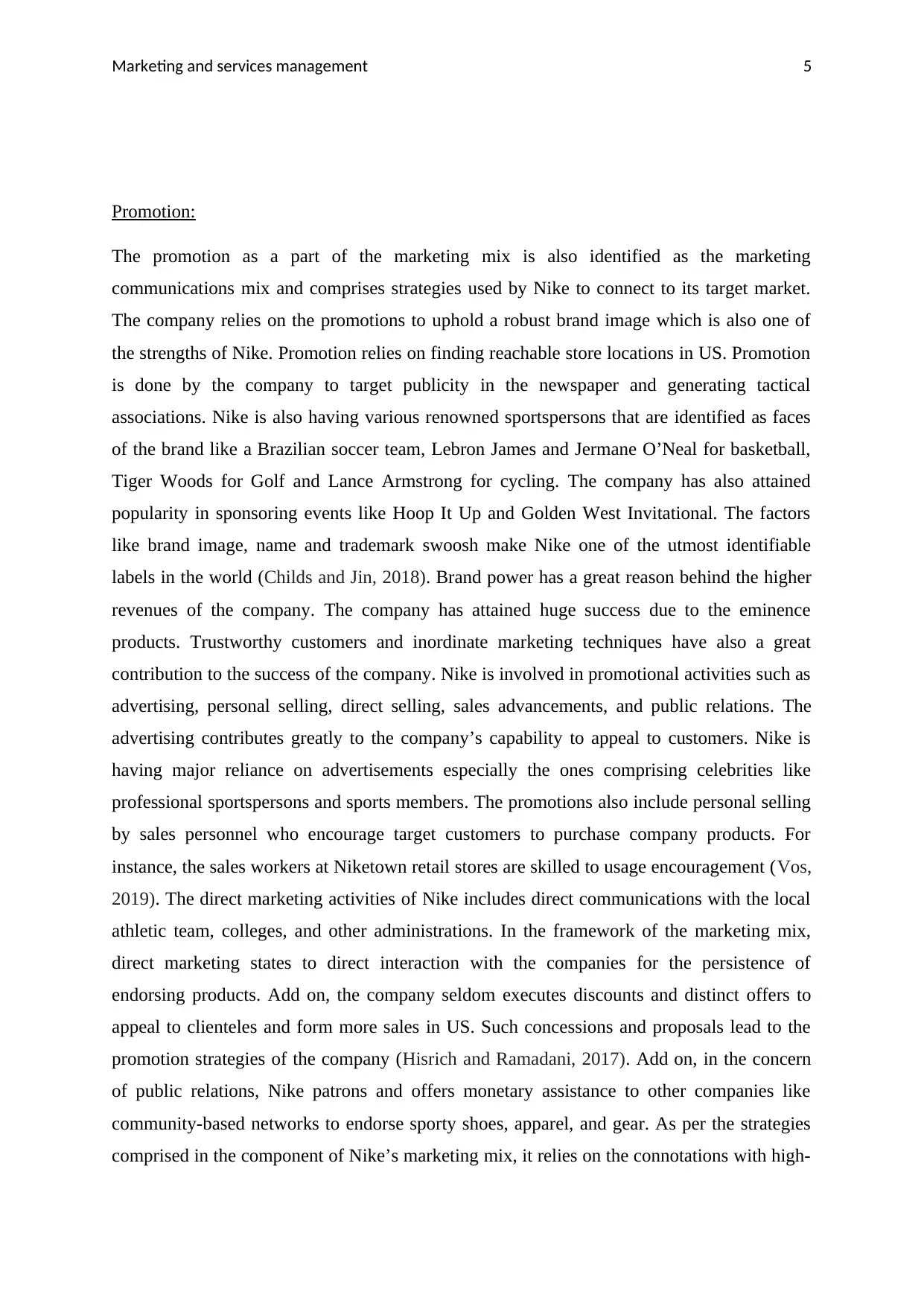
Marketing and services management 5
Promotion:
The promotion as a part of the marketing mix is also identified as the marketing
communications mix and comprises strategies used by Nike to connect to its target market.
The company relies on the promotions to uphold a robust brand image which is also one of
the strengths of Nike. Promotion relies on finding reachable store locations in US. Promotion
is done by the company to target publicity in the newspaper and generating tactical
associations. Nike is also having various renowned sportspersons that are identified as faces
of the brand like a Brazilian soccer team, Lebron James and Jermane O’Neal for basketball,
Tiger Woods for Golf and Lance Armstrong for cycling. The company has also attained
popularity in sponsoring events like Hoop It Up and Golden West Invitational. The factors
like brand image, name and trademark swoosh make Nike one of the utmost identifiable
labels in the world (Childs and Jin, 2018). Brand power has a great reason behind the higher
revenues of the company. The company has attained huge success due to the eminence
products. Trustworthy customers and inordinate marketing techniques have also a great
contribution to the success of the company. Nike is involved in promotional activities such as
advertising, personal selling, direct selling, sales advancements, and public relations. The
advertising contributes greatly to the company’s capability to appeal to customers. Nike is
having major reliance on advertisements especially the ones comprising celebrities like
professional sportspersons and sports members. The promotions also include personal selling
by sales personnel who encourage target customers to purchase company products. For
instance, the sales workers at Niketown retail stores are skilled to usage encouragement (Vos,
2019). The direct marketing activities of Nike includes direct communications with the local
athletic team, colleges, and other administrations. In the framework of the marketing mix,
direct marketing states to direct interaction with the companies for the persistence of
endorsing products. Add on, the company seldom executes discounts and distinct offers to
appeal to clienteles and form more sales in US. Such concessions and proposals lead to the
promotion strategies of the company (Hisrich and Ramadani, 2017). Add on, in the concern
of public relations, Nike patrons and offers monetary assistance to other companies like
community-based networks to endorse sporty shoes, apparel, and gear. As per the strategies
comprised in the component of Nike’s marketing mix, it relies on the connotations with high-
Promotion:
The promotion as a part of the marketing mix is also identified as the marketing
communications mix and comprises strategies used by Nike to connect to its target market.
The company relies on the promotions to uphold a robust brand image which is also one of
the strengths of Nike. Promotion relies on finding reachable store locations in US. Promotion
is done by the company to target publicity in the newspaper and generating tactical
associations. Nike is also having various renowned sportspersons that are identified as faces
of the brand like a Brazilian soccer team, Lebron James and Jermane O’Neal for basketball,
Tiger Woods for Golf and Lance Armstrong for cycling. The company has also attained
popularity in sponsoring events like Hoop It Up and Golden West Invitational. The factors
like brand image, name and trademark swoosh make Nike one of the utmost identifiable
labels in the world (Childs and Jin, 2018). Brand power has a great reason behind the higher
revenues of the company. The company has attained huge success due to the eminence
products. Trustworthy customers and inordinate marketing techniques have also a great
contribution to the success of the company. Nike is involved in promotional activities such as
advertising, personal selling, direct selling, sales advancements, and public relations. The
advertising contributes greatly to the company’s capability to appeal to customers. Nike is
having major reliance on advertisements especially the ones comprising celebrities like
professional sportspersons and sports members. The promotions also include personal selling
by sales personnel who encourage target customers to purchase company products. For
instance, the sales workers at Niketown retail stores are skilled to usage encouragement (Vos,
2019). The direct marketing activities of Nike includes direct communications with the local
athletic team, colleges, and other administrations. In the framework of the marketing mix,
direct marketing states to direct interaction with the companies for the persistence of
endorsing products. Add on, the company seldom executes discounts and distinct offers to
appeal to clienteles and form more sales in US. Such concessions and proposals lead to the
promotion strategies of the company (Hisrich and Ramadani, 2017). Add on, in the concern
of public relations, Nike patrons and offers monetary assistance to other companies like
community-based networks to endorse sporty shoes, apparel, and gear. As per the strategies
comprised in the component of Nike’s marketing mix, it relies on the connotations with high-
⊘ This is a preview!⊘
Do you want full access?
Subscribe today to unlock all pages.

Trusted by 1+ million students worldwide
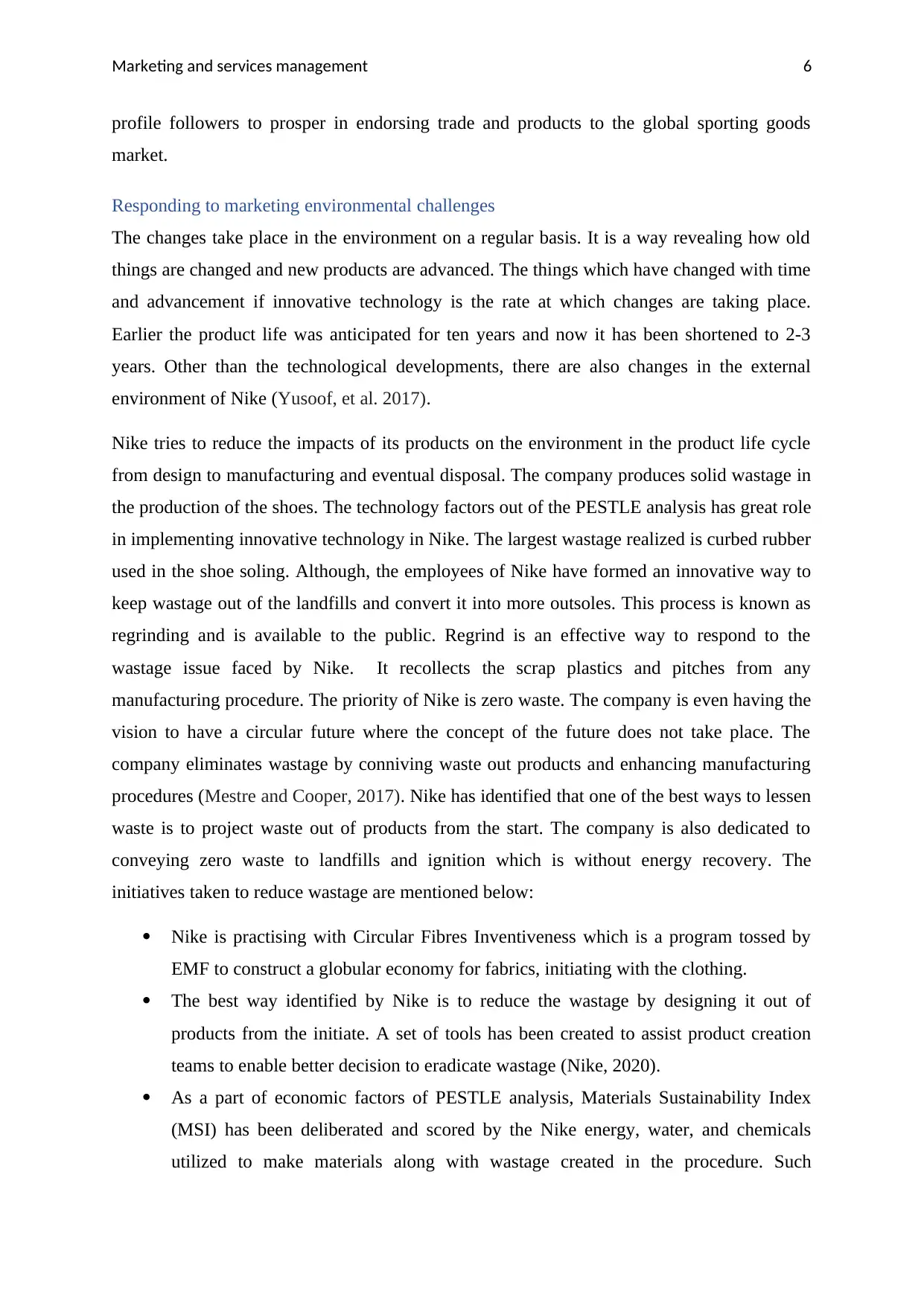
Marketing and services management 6
profile followers to prosper in endorsing trade and products to the global sporting goods
market.
Responding to marketing environmental challenges
The changes take place in the environment on a regular basis. It is a way revealing how old
things are changed and new products are advanced. The things which have changed with time
and advancement if innovative technology is the rate at which changes are taking place.
Earlier the product life was anticipated for ten years and now it has been shortened to 2-3
years. Other than the technological developments, there are also changes in the external
environment of Nike (Yusoof, et al. 2017).
Nike tries to reduce the impacts of its products on the environment in the product life cycle
from design to manufacturing and eventual disposal. The company produces solid wastage in
the production of the shoes. The technology factors out of the PESTLE analysis has great role
in implementing innovative technology in Nike. The largest wastage realized is curbed rubber
used in the shoe soling. Although, the employees of Nike have formed an innovative way to
keep wastage out of the landfills and convert it into more outsoles. This process is known as
regrinding and is available to the public. Regrind is an effective way to respond to the
wastage issue faced by Nike. It recollects the scrap plastics and pitches from any
manufacturing procedure. The priority of Nike is zero waste. The company is even having the
vision to have a circular future where the concept of the future does not take place. The
company eliminates wastage by conniving waste out products and enhancing manufacturing
procedures (Mestre and Cooper, 2017). Nike has identified that one of the best ways to lessen
waste is to project waste out of products from the start. The company is also dedicated to
conveying zero waste to landfills and ignition which is without energy recovery. The
initiatives taken to reduce wastage are mentioned below:
Nike is practising with Circular Fibres Inventiveness which is a program tossed by
EMF to construct a globular economy for fabrics, initiating with the clothing.
The best way identified by Nike is to reduce the wastage by designing it out of
products from the initiate. A set of tools has been created to assist product creation
teams to enable better decision to eradicate wastage (Nike, 2020).
As a part of economic factors of PESTLE analysis, Materials Sustainability Index
(MSI) has been deliberated and scored by the Nike energy, water, and chemicals
utilized to make materials along with wastage created in the procedure. Such
profile followers to prosper in endorsing trade and products to the global sporting goods
market.
Responding to marketing environmental challenges
The changes take place in the environment on a regular basis. It is a way revealing how old
things are changed and new products are advanced. The things which have changed with time
and advancement if innovative technology is the rate at which changes are taking place.
Earlier the product life was anticipated for ten years and now it has been shortened to 2-3
years. Other than the technological developments, there are also changes in the external
environment of Nike (Yusoof, et al. 2017).
Nike tries to reduce the impacts of its products on the environment in the product life cycle
from design to manufacturing and eventual disposal. The company produces solid wastage in
the production of the shoes. The technology factors out of the PESTLE analysis has great role
in implementing innovative technology in Nike. The largest wastage realized is curbed rubber
used in the shoe soling. Although, the employees of Nike have formed an innovative way to
keep wastage out of the landfills and convert it into more outsoles. This process is known as
regrinding and is available to the public. Regrind is an effective way to respond to the
wastage issue faced by Nike. It recollects the scrap plastics and pitches from any
manufacturing procedure. The priority of Nike is zero waste. The company is even having the
vision to have a circular future where the concept of the future does not take place. The
company eliminates wastage by conniving waste out products and enhancing manufacturing
procedures (Mestre and Cooper, 2017). Nike has identified that one of the best ways to lessen
waste is to project waste out of products from the start. The company is also dedicated to
conveying zero waste to landfills and ignition which is without energy recovery. The
initiatives taken to reduce wastage are mentioned below:
Nike is practising with Circular Fibres Inventiveness which is a program tossed by
EMF to construct a globular economy for fabrics, initiating with the clothing.
The best way identified by Nike is to reduce the wastage by designing it out of
products from the initiate. A set of tools has been created to assist product creation
teams to enable better decision to eradicate wastage (Nike, 2020).
As a part of economic factors of PESTLE analysis, Materials Sustainability Index
(MSI) has been deliberated and scored by the Nike energy, water, and chemicals
utilized to make materials along with wastage created in the procedure. Such
Paraphrase This Document
Need a fresh take? Get an instant paraphrase of this document with our AI Paraphraser
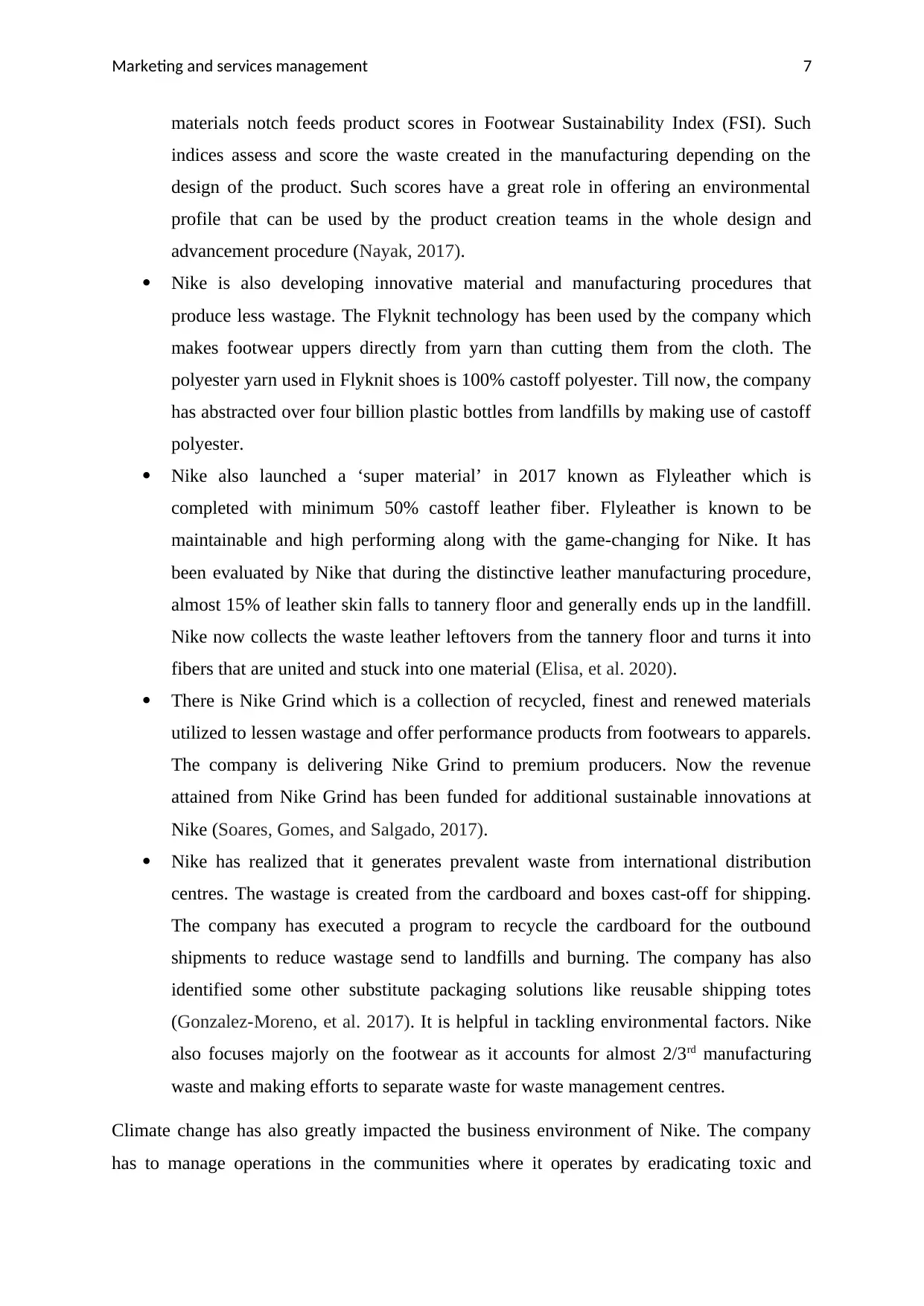
Marketing and services management 7
materials notch feeds product scores in Footwear Sustainability Index (FSI). Such
indices assess and score the waste created in the manufacturing depending on the
design of the product. Such scores have a great role in offering an environmental
profile that can be used by the product creation teams in the whole design and
advancement procedure (Nayak, 2017).
Nike is also developing innovative material and manufacturing procedures that
produce less wastage. The Flyknit technology has been used by the company which
makes footwear uppers directly from yarn than cutting them from the cloth. The
polyester yarn used in Flyknit shoes is 100% castoff polyester. Till now, the company
has abstracted over four billion plastic bottles from landfills by making use of castoff
polyester.
Nike also launched a ‘super material’ in 2017 known as Flyleather which is
completed with minimum 50% castoff leather fiber. Flyleather is known to be
maintainable and high performing along with the game-changing for Nike. It has
been evaluated by Nike that during the distinctive leather manufacturing procedure,
almost 15% of leather skin falls to tannery floor and generally ends up in the landfill.
Nike now collects the waste leather leftovers from the tannery floor and turns it into
fibers that are united and stuck into one material (Elisa, et al. 2020).
There is Nike Grind which is a collection of recycled, finest and renewed materials
utilized to lessen wastage and offer performance products from footwears to apparels.
The company is delivering Nike Grind to premium producers. Now the revenue
attained from Nike Grind has been funded for additional sustainable innovations at
Nike (Soares, Gomes, and Salgado, 2017).
Nike has realized that it generates prevalent waste from international distribution
centres. The wastage is created from the cardboard and boxes cast-off for shipping.
The company has executed a program to recycle the cardboard for the outbound
shipments to reduce wastage send to landfills and burning. The company has also
identified some other substitute packaging solutions like reusable shipping totes
(Gonzalez-Moreno, et al. 2017). It is helpful in tackling environmental factors. Nike
also focuses majorly on the footwear as it accounts for almost 2/3rd manufacturing
waste and making efforts to separate waste for waste management centres.
Climate change has also greatly impacted the business environment of Nike. The company
has to manage operations in the communities where it operates by eradicating toxic and
materials notch feeds product scores in Footwear Sustainability Index (FSI). Such
indices assess and score the waste created in the manufacturing depending on the
design of the product. Such scores have a great role in offering an environmental
profile that can be used by the product creation teams in the whole design and
advancement procedure (Nayak, 2017).
Nike is also developing innovative material and manufacturing procedures that
produce less wastage. The Flyknit technology has been used by the company which
makes footwear uppers directly from yarn than cutting them from the cloth. The
polyester yarn used in Flyknit shoes is 100% castoff polyester. Till now, the company
has abstracted over four billion plastic bottles from landfills by making use of castoff
polyester.
Nike also launched a ‘super material’ in 2017 known as Flyleather which is
completed with minimum 50% castoff leather fiber. Flyleather is known to be
maintainable and high performing along with the game-changing for Nike. It has
been evaluated by Nike that during the distinctive leather manufacturing procedure,
almost 15% of leather skin falls to tannery floor and generally ends up in the landfill.
Nike now collects the waste leather leftovers from the tannery floor and turns it into
fibers that are united and stuck into one material (Elisa, et al. 2020).
There is Nike Grind which is a collection of recycled, finest and renewed materials
utilized to lessen wastage and offer performance products from footwears to apparels.
The company is delivering Nike Grind to premium producers. Now the revenue
attained from Nike Grind has been funded for additional sustainable innovations at
Nike (Soares, Gomes, and Salgado, 2017).
Nike has realized that it generates prevalent waste from international distribution
centres. The wastage is created from the cardboard and boxes cast-off for shipping.
The company has executed a program to recycle the cardboard for the outbound
shipments to reduce wastage send to landfills and burning. The company has also
identified some other substitute packaging solutions like reusable shipping totes
(Gonzalez-Moreno, et al. 2017). It is helpful in tackling environmental factors. Nike
also focuses majorly on the footwear as it accounts for almost 2/3rd manufacturing
waste and making efforts to separate waste for waste management centres.
Climate change has also greatly impacted the business environment of Nike. The company
has to manage operations in the communities where it operates by eradicating toxic and
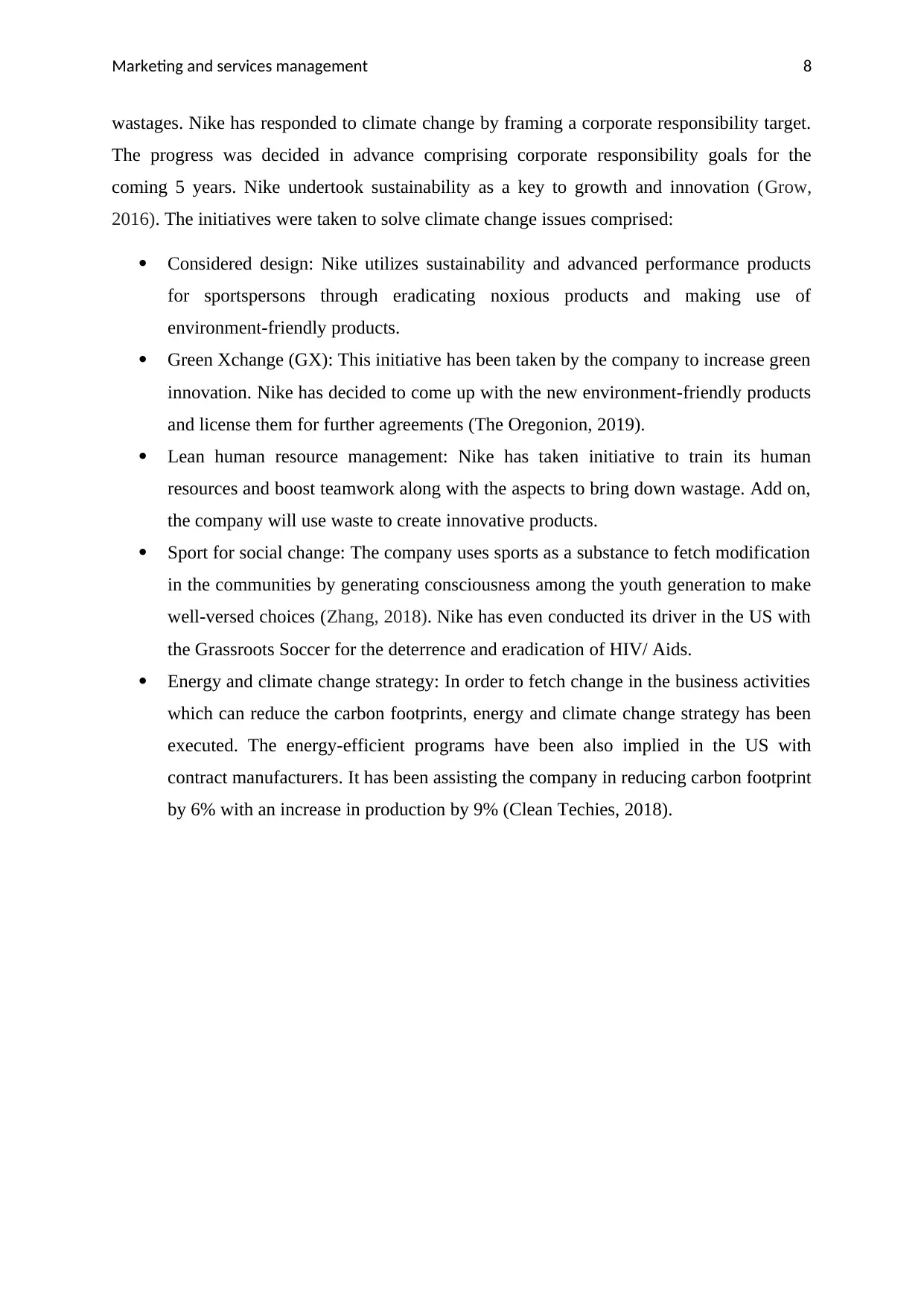
Marketing and services management 8
wastages. Nike has responded to climate change by framing a corporate responsibility target.
The progress was decided in advance comprising corporate responsibility goals for the
coming 5 years. Nike undertook sustainability as a key to growth and innovation (Grow,
2016). The initiatives were taken to solve climate change issues comprised:
Considered design: Nike utilizes sustainability and advanced performance products
for sportspersons through eradicating noxious products and making use of
environment-friendly products.
Green Xchange (GX): This initiative has been taken by the company to increase green
innovation. Nike has decided to come up with the new environment-friendly products
and license them for further agreements (The Oregonion, 2019).
Lean human resource management: Nike has taken initiative to train its human
resources and boost teamwork along with the aspects to bring down wastage. Add on,
the company will use waste to create innovative products.
Sport for social change: The company uses sports as a substance to fetch modification
in the communities by generating consciousness among the youth generation to make
well-versed choices (Zhang, 2018). Nike has even conducted its driver in the US with
the Grassroots Soccer for the deterrence and eradication of HIV/ Aids.
Energy and climate change strategy: In order to fetch change in the business activities
which can reduce the carbon footprints, energy and climate change strategy has been
executed. The energy-efficient programs have been also implied in the US with
contract manufacturers. It has been assisting the company in reducing carbon footprint
by 6% with an increase in production by 9% (Clean Techies, 2018).
wastages. Nike has responded to climate change by framing a corporate responsibility target.
The progress was decided in advance comprising corporate responsibility goals for the
coming 5 years. Nike undertook sustainability as a key to growth and innovation (Grow,
2016). The initiatives were taken to solve climate change issues comprised:
Considered design: Nike utilizes sustainability and advanced performance products
for sportspersons through eradicating noxious products and making use of
environment-friendly products.
Green Xchange (GX): This initiative has been taken by the company to increase green
innovation. Nike has decided to come up with the new environment-friendly products
and license them for further agreements (The Oregonion, 2019).
Lean human resource management: Nike has taken initiative to train its human
resources and boost teamwork along with the aspects to bring down wastage. Add on,
the company will use waste to create innovative products.
Sport for social change: The company uses sports as a substance to fetch modification
in the communities by generating consciousness among the youth generation to make
well-versed choices (Zhang, 2018). Nike has even conducted its driver in the US with
the Grassroots Soccer for the deterrence and eradication of HIV/ Aids.
Energy and climate change strategy: In order to fetch change in the business activities
which can reduce the carbon footprints, energy and climate change strategy has been
executed. The energy-efficient programs have been also implied in the US with
contract manufacturers. It has been assisting the company in reducing carbon footprint
by 6% with an increase in production by 9% (Clean Techies, 2018).
⊘ This is a preview!⊘
Do you want full access?
Subscribe today to unlock all pages.

Trusted by 1+ million students worldwide

Marketing and services management 9
References
Balan, C., 2017, September. Nike on Instagram: Themes of Branded Content and Their
Engagement Power. In CBU International Conference Proceedings (Vol. 5, pp. 13-18).
Childs, M. and Jin, B., 2018. Nike: An Innovation Journey. In Product Innovation in the
Global Fashion Industry (pp. 79-111). Palgrave Pivot, New York.
Clean Techies, 2018. Top Ten Sustainability Initiatives of Nike. Available from
https://cleantechies.com/2012/02/13/top-ten-sustainability-initiatives-of-nike/ [Accessed on
14/02/2020]
Constantine, I., 2018. An analysis of the nature and role of reciprocity within the Nike x
Basement Collective co-creation strategy. Journal of Promotional Communications, 6(2).
Elisa, P., Alessandro, P., Andrea, A., Silvia, B., Mathis, P., Dominik, P., Manuela, R.,
Francesca, T., Voglar, G.E., Tine, G. and Nike, K., 2020. Environmental and climate change
impacts of eighteen biomass-based plants in the alpine region: A comparative
analysis. Journal of Cleaner Production, 242, p.118449.
Gonzalez-Moreno, A., Valencia-Hernandez, A. and Valencia-Hernandez, O., 2017. The
Effectiveness of Environmental Design for Physical Activities Promotion. The Design
Journal, 20(sup1), pp.S2498-S2523.
Grow, J.M., 2016. Stories of community: The first ten years of Nike women’s
advertising. The American Journal of Semiotics, 22(1/4), pp.167-196.
Hisrich, R.D. and Ramadani, V., 2017. Entrepreneurial marketing mix. In Effective
Entrepreneurial Management (pp. 75-99). Springer, Cham.
Hoffmann, F., Batchelor, R.P. and Manning, M.J., 2016. Nike and Popular Culture.
In Basketball in America (pp. 63-76). Routledge.
Jialiing, W., 2017. Research on the Current Situation of Nike Sportswear Consumption of
Female College Students in Shanghai University of Sport. Contemporary Sports Technology,
(20), p.115.
Jiang, W., 2019. Sustainable Development of Supply Chain in Footwear Industry–Take Nike
as the Case. Asian Business Research, 4(3), p.86.
References
Balan, C., 2017, September. Nike on Instagram: Themes of Branded Content and Their
Engagement Power. In CBU International Conference Proceedings (Vol. 5, pp. 13-18).
Childs, M. and Jin, B., 2018. Nike: An Innovation Journey. In Product Innovation in the
Global Fashion Industry (pp. 79-111). Palgrave Pivot, New York.
Clean Techies, 2018. Top Ten Sustainability Initiatives of Nike. Available from
https://cleantechies.com/2012/02/13/top-ten-sustainability-initiatives-of-nike/ [Accessed on
14/02/2020]
Constantine, I., 2018. An analysis of the nature and role of reciprocity within the Nike x
Basement Collective co-creation strategy. Journal of Promotional Communications, 6(2).
Elisa, P., Alessandro, P., Andrea, A., Silvia, B., Mathis, P., Dominik, P., Manuela, R.,
Francesca, T., Voglar, G.E., Tine, G. and Nike, K., 2020. Environmental and climate change
impacts of eighteen biomass-based plants in the alpine region: A comparative
analysis. Journal of Cleaner Production, 242, p.118449.
Gonzalez-Moreno, A., Valencia-Hernandez, A. and Valencia-Hernandez, O., 2017. The
Effectiveness of Environmental Design for Physical Activities Promotion. The Design
Journal, 20(sup1), pp.S2498-S2523.
Grow, J.M., 2016. Stories of community: The first ten years of Nike women’s
advertising. The American Journal of Semiotics, 22(1/4), pp.167-196.
Hisrich, R.D. and Ramadani, V., 2017. Entrepreneurial marketing mix. In Effective
Entrepreneurial Management (pp. 75-99). Springer, Cham.
Hoffmann, F., Batchelor, R.P. and Manning, M.J., 2016. Nike and Popular Culture.
In Basketball in America (pp. 63-76). Routledge.
Jialiing, W., 2017. Research on the Current Situation of Nike Sportswear Consumption of
Female College Students in Shanghai University of Sport. Contemporary Sports Technology,
(20), p.115.
Jiang, W., 2019. Sustainable Development of Supply Chain in Footwear Industry–Take Nike
as the Case. Asian Business Research, 4(3), p.86.
Paraphrase This Document
Need a fresh take? Get an instant paraphrase of this document with our AI Paraphraser
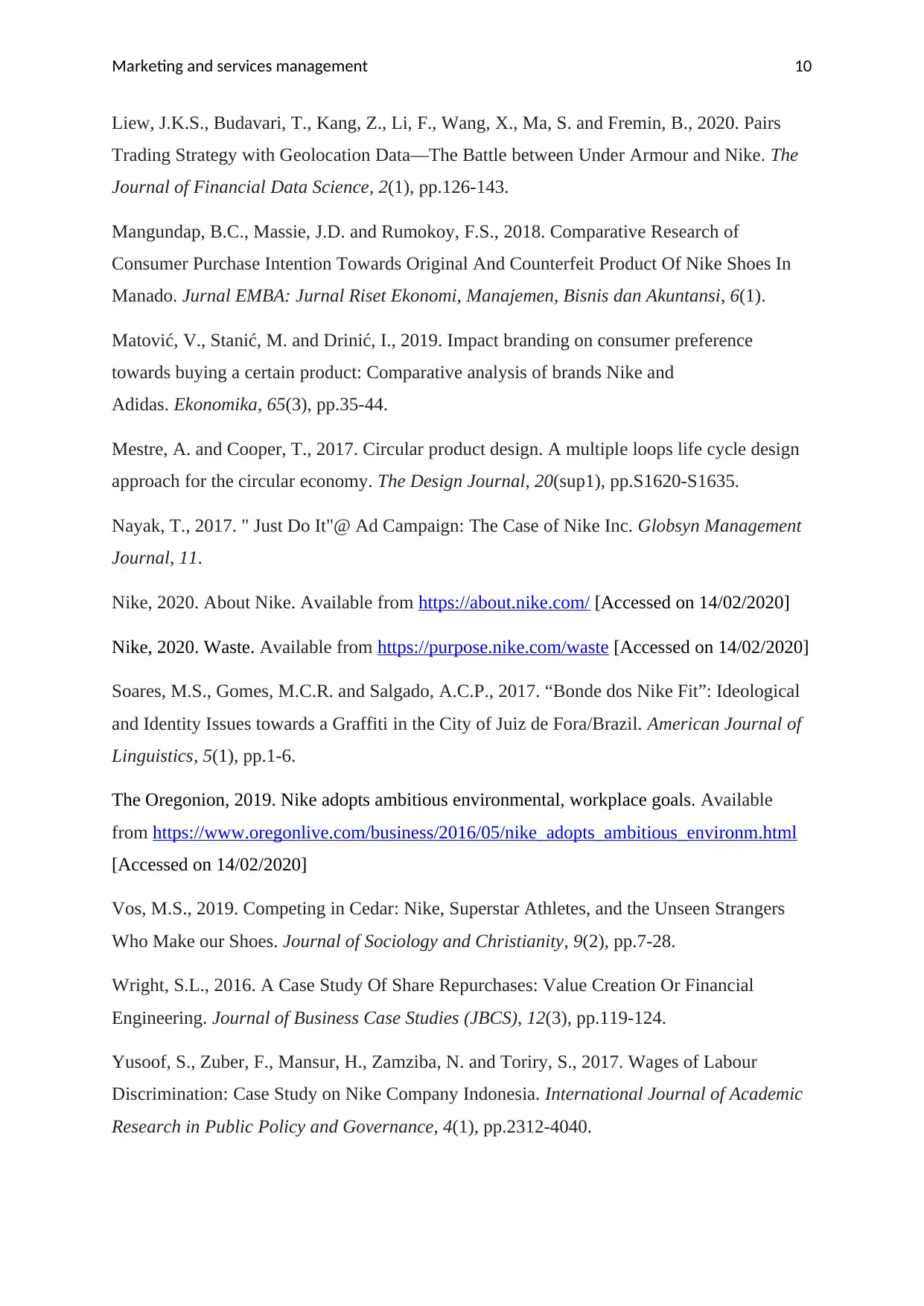
Marketing and services management 10
Liew, J.K.S., Budavari, T., Kang, Z., Li, F., Wang, X., Ma, S. and Fremin, B., 2020. Pairs
Trading Strategy with Geolocation Data—The Battle between Under Armour and Nike. The
Journal of Financial Data Science, 2(1), pp.126-143.
Mangundap, B.C., Massie, J.D. and Rumokoy, F.S., 2018. Comparative Research of
Consumer Purchase Intention Towards Original And Counterfeit Product Of Nike Shoes In
Manado. Jurnal EMBA: Jurnal Riset Ekonomi, Manajemen, Bisnis dan Akuntansi, 6(1).
Matović, V., Stanić, M. and Drinić, I., 2019. Impact branding on consumer preference
towards buying a certain product: Comparative analysis of brands Nike and
Adidas. Ekonomika, 65(3), pp.35-44.
Mestre, A. and Cooper, T., 2017. Circular product design. A multiple loops life cycle design
approach for the circular economy. The Design Journal, 20(sup1), pp.S1620-S1635.
Nayak, T., 2017. " Just Do It"@ Ad Campaign: The Case of Nike Inc. Globsyn Management
Journal, 11.
Nike, 2020. About Nike. Available from https://about.nike.com/ [Accessed on 14/02/2020]
Nike, 2020. Waste. Available from https://purpose.nike.com/waste [Accessed on 14/02/2020]
Soares, M.S., Gomes, M.C.R. and Salgado, A.C.P., 2017. “Bonde dos Nike Fit”: Ideological
and Identity Issues towards a Graffiti in the City of Juiz de Fora/Brazil. American Journal of
Linguistics, 5(1), pp.1-6.
The Oregonion, 2019. Nike adopts ambitious environmental, workplace goals. Available
from https://www.oregonlive.com/business/2016/05/nike_adopts_ambitious_environm.html
[Accessed on 14/02/2020]
Vos, M.S., 2019. Competing in Cedar: Nike, Superstar Athletes, and the Unseen Strangers
Who Make our Shoes. Journal of Sociology and Christianity, 9(2), pp.7-28.
Wright, S.L., 2016. A Case Study Of Share Repurchases: Value Creation Or Financial
Engineering. Journal of Business Case Studies (JBCS), 12(3), pp.119-124.
Yusoof, S., Zuber, F., Mansur, H., Zamziba, N. and Toriry, S., 2017. Wages of Labour
Discrimination: Case Study on Nike Company Indonesia. International Journal of Academic
Research in Public Policy and Governance, 4(1), pp.2312-4040.
Liew, J.K.S., Budavari, T., Kang, Z., Li, F., Wang, X., Ma, S. and Fremin, B., 2020. Pairs
Trading Strategy with Geolocation Data—The Battle between Under Armour and Nike. The
Journal of Financial Data Science, 2(1), pp.126-143.
Mangundap, B.C., Massie, J.D. and Rumokoy, F.S., 2018. Comparative Research of
Consumer Purchase Intention Towards Original And Counterfeit Product Of Nike Shoes In
Manado. Jurnal EMBA: Jurnal Riset Ekonomi, Manajemen, Bisnis dan Akuntansi, 6(1).
Matović, V., Stanić, M. and Drinić, I., 2019. Impact branding on consumer preference
towards buying a certain product: Comparative analysis of brands Nike and
Adidas. Ekonomika, 65(3), pp.35-44.
Mestre, A. and Cooper, T., 2017. Circular product design. A multiple loops life cycle design
approach for the circular economy. The Design Journal, 20(sup1), pp.S1620-S1635.
Nayak, T., 2017. " Just Do It"@ Ad Campaign: The Case of Nike Inc. Globsyn Management
Journal, 11.
Nike, 2020. About Nike. Available from https://about.nike.com/ [Accessed on 14/02/2020]
Nike, 2020. Waste. Available from https://purpose.nike.com/waste [Accessed on 14/02/2020]
Soares, M.S., Gomes, M.C.R. and Salgado, A.C.P., 2017. “Bonde dos Nike Fit”: Ideological
and Identity Issues towards a Graffiti in the City of Juiz de Fora/Brazil. American Journal of
Linguistics, 5(1), pp.1-6.
The Oregonion, 2019. Nike adopts ambitious environmental, workplace goals. Available
from https://www.oregonlive.com/business/2016/05/nike_adopts_ambitious_environm.html
[Accessed on 14/02/2020]
Vos, M.S., 2019. Competing in Cedar: Nike, Superstar Athletes, and the Unseen Strangers
Who Make our Shoes. Journal of Sociology and Christianity, 9(2), pp.7-28.
Wright, S.L., 2016. A Case Study Of Share Repurchases: Value Creation Or Financial
Engineering. Journal of Business Case Studies (JBCS), 12(3), pp.119-124.
Yusoof, S., Zuber, F., Mansur, H., Zamziba, N. and Toriry, S., 2017. Wages of Labour
Discrimination: Case Study on Nike Company Indonesia. International Journal of Academic
Research in Public Policy and Governance, 4(1), pp.2312-4040.

Marketing and services management 11
Zhang, J., 2018, August. Strategy of Sports Brand Network Marketing on the Basis of Brand
Image Promotion. In 2018 International Conference on Management, Economics, Education
and Social Sciences (MEESS 2018). Atlantis Press.
Zhang, J., 2018, August. Strategy of Sports Brand Network Marketing on the Basis of Brand
Image Promotion. In 2018 International Conference on Management, Economics, Education
and Social Sciences (MEESS 2018). Atlantis Press.
⊘ This is a preview!⊘
Do you want full access?
Subscribe today to unlock all pages.

Trusted by 1+ million students worldwide
1 out of 12
Related Documents
Your All-in-One AI-Powered Toolkit for Academic Success.
+13062052269
info@desklib.com
Available 24*7 on WhatsApp / Email
![[object Object]](/_next/static/media/star-bottom.7253800d.svg)
Unlock your academic potential
Copyright © 2020–2025 A2Z Services. All Rights Reserved. Developed and managed by ZUCOL.





